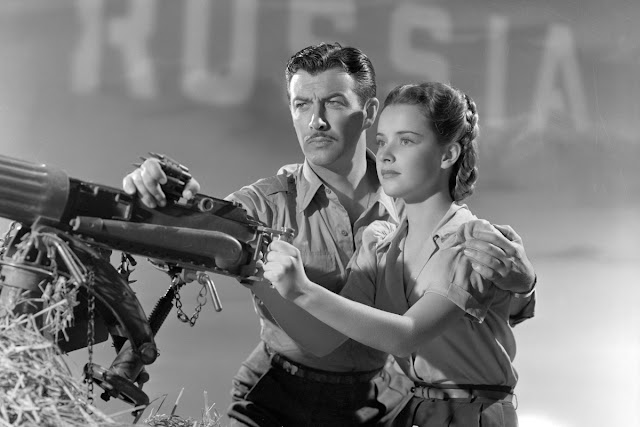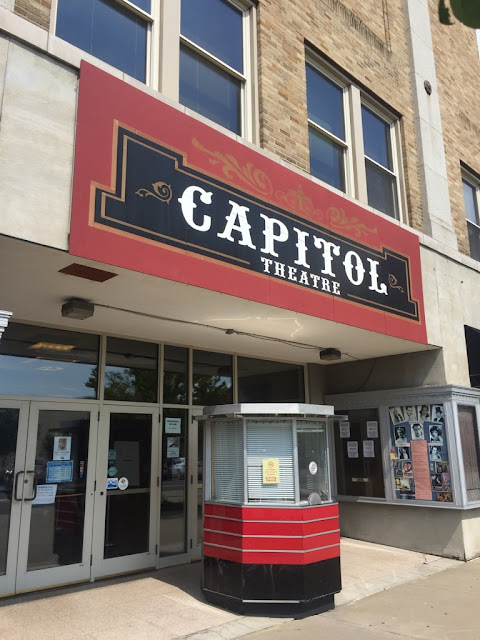 |
| Anna Karina in Band of Outsiders (1964) |
Band of Outsiders, known in French as Bande à part, is a Jean-Luc Godard film from 1964 starring Godard muse Anna Karina. She plays Odile, a naive young woman studying English with fellow students Franz (Sami Frey) and Arthur (Claude Brasseur). Odile becomes the object of fascination for both Franz and Arthur. They lust after her and when she reveals a crucial bit of information about a store of money in her aunt’s home, they use her as a means to an end. Arthur owes his uncle some serious cash to his uncle so he needs to get his hands on this money right away. Things spiral out of control as the urgency grows and things don’t go according to plan. There are some lighthearted moments in the film including the iconic scene of Karina, Frey & Brasseur dancing in a nightclub. That scene inspired Uma Thurman and John Travolta's dance in Pulp Fiction and the film as a whole made a mark on director Quentin Tarantino.
I first saw this film at the 2016 TCM Classic Film Festival in Hollywood. It was a very special event because the film’s star Anna Karina was in attendance and the audience was treated to an interview with her by Ben Mankiewicz of TCM. This event had been buzzed about for months before the festival, especially by me and other fans of French cinema and Karina herself. Mankiewicz kicked off the interview by saying “we're celebrating a movie that's over 50 years old and... the buzz at this festival from the moment we announced you were here was palpable." French New Wave films like Band of Outsiders still resonate today because of actresses like Anna Karina. She was a major influence on culture and is mesmerizing to watch on screen. Karina remains modest about her influence saying "I'm very excited to see that so many people still like the film".
 |
| Anna Karina and Ben Mannkiewicz at the 2016 TCM Classic Film Festival |
From a young age, Karina loved the movies. She started off singing and dancing in her native country of Denmark. She was an extra in Danish films as a young teen. Karina remembers, "One day someone saw me in the street and he said would you like to be in my film?" She said why not but had to ask her mother because she was 14 years old. She got her mother's permission and made the film The Girl with the Shoes, aka Pigen Og Skoene (1959) . Four years later the short got a prize at the Cannes Film Festival. By that time she was already an established actress in France.
Karina moved to Paris while still a teen. She didn't have much money so she did some work in TV commercials including one for Palmolive soap. Godard saw the commercial and offered Karina a part in his upcoming film Breathless (1960) and he said "but you have to take your clothes off." Karina’s response was direct, "I'm not talking my clothes off." She later reminisced about turning that iconic film down:
"I didn't want to do it so I didn't do it. [Godard] didn't understand because he thought I was nude in the soap film. But you only saw a bit of shoulder... It was in his imagination.” - Anna Karina
 |
| Anna Karina at the 2016 TCM Classic Film Festival |
Three months later she got an offer for a lead part in a Godard film. By that time she had forgotten all about him. She consulted her friends who pointed out that Godard had made an amazing film called Breathless with Jean Paul Belmondo. She went to meet Godard and asked him if she had to take her clothes off. His response was, "no it's a political film". Karina was concerned because she was so young and still learning how to speak French. How would she make a political film? Godard responded "Don't you worry about it, you just do what I tell you to do". There was a bit of a snafu because Karina was still underage and needed permission. Her father wasn't in her life anymore and her mother was living in Copenhagen. Godard offered to bring her mother to Paris. Karina hadn't seen her mother in 8 months and called her up saying "Mommy I'm doing a political film in Paris with a great director called Jean Luc-Godard. You have to come to sign the contract.” Her mother didn't believe her and hung up the phone. She finally convinced her mother to come to sign the contract and the rest is history.
Ben Mankiewicz asked if Karina had ever auditioned for Godard. She hadn’t. She signed the contract and that was it. There was a test where Godard filmed a sort of interview with Karina to see how she’d do on screen. One of the questions he asked her was how many boys she had been with and she told him it was none of his business.
Karina eventually let her guard down and she and Godard fell in love. He was a romantic and she was his muse but they still had to work together. Mankiewicz asked Karina if Godard was a difficult director. "In a way yes", replied Karina. For Band of Outsiders, they had no script and had to learn their dialogue every morning. The dynamic between the actors and director meant that they knew what to do and what Godard wanted even without a script. Godard said that if he had a script in the end he wouldn't have wanted to do the film. He made a kind of script for the producer so they knew what to do. Karina remembers that Godard didn't direct very much because he trusted the actors. Karina likened the acting to music. You just felt it and it made sense.
 |
| Jean-Luc Godard and Anna Karina |
And about that famous dance scene Karina remembered that they had to rehearse for three weeks. Every night after shooting, they would go to a night club and practice for an hour before the night club opened to patrons.
Note: this piece was transcribed from the 2016 TCM Classic Film Festival interview with Ben Mankiewicz and Anna Karina. Quotes and paraphrasing are used.








































